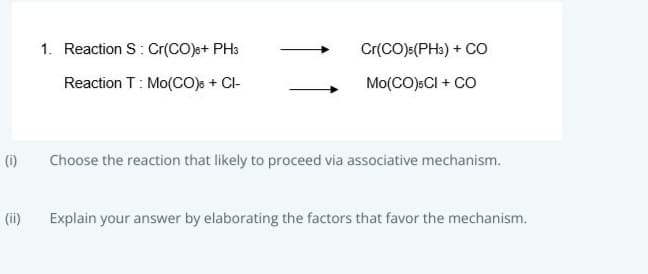1. Reaction S: Cr(CO)e+ PH3 Cr(CO)s(PH3) + Co Reaction T: Mo(CO)p + Cl- Mo(CO)sCI + CO Choose the reaction that likely to proceed via associative mechanism. Explain your answer by elaborating the factors that favor the mechanism.
1. Reaction S: Cr(CO)e+ PH3 Cr(CO)s(PH3) + Co Reaction T: Mo(CO)p + Cl- Mo(CO)sCI + CO Choose the reaction that likely to proceed via associative mechanism. Explain your answer by elaborating the factors that favor the mechanism.
Chapter13: Kinetic Methods
Section: Chapter Questions
Problem 8P
Related questions
Question

Transcribed Image Text:1. Reaction S: Cr(CO)s+ PH3
Cr(CO)s(PH3) + CO
Reaction T: Mo(CO)s + Cl-
Mo(CO):CI + CO
(i)
Choose the reaction that likely to proceed via associative mechanism.
(ii)
Explain your answer by elaborating the factors that favor the mechanism.
Expert Solution
This question has been solved!
Explore an expertly crafted, step-by-step solution for a thorough understanding of key concepts.
Step by step
Solved in 2 steps with 1 images

Knowledge Booster
Learn more about
Need a deep-dive on the concept behind this application? Look no further. Learn more about this topic, chemistry and related others by exploring similar questions and additional content below.Recommended textbooks for you


Principles of Instrumental Analysis
Chemistry
ISBN:
9781305577213
Author:
Douglas A. Skoog, F. James Holler, Stanley R. Crouch
Publisher:
Cengage Learning

Chemistry: The Molecular Science
Chemistry
ISBN:
9781285199047
Author:
John W. Moore, Conrad L. Stanitski
Publisher:
Cengage Learning


Principles of Instrumental Analysis
Chemistry
ISBN:
9781305577213
Author:
Douglas A. Skoog, F. James Holler, Stanley R. Crouch
Publisher:
Cengage Learning

Chemistry: The Molecular Science
Chemistry
ISBN:
9781285199047
Author:
John W. Moore, Conrad L. Stanitski
Publisher:
Cengage Learning